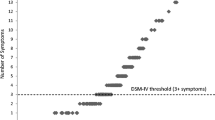Abstract
Confirmatory factor analysis (CFA) was used to evaluate five different models for the organization of the DSM-IV ADHD and oppositional defiant disorder (ODD) symptoms (Model 1: a single factor model; Model 2: an ADHD and ODD two factor model; Model 3a: an inattention (INA), hyperactivity/impulsivity (HYP/IMP), and ODD three factor model; Model 3b: an INA, HYP/IMP, and ODD three factor model where the three IMP symptoms cross-load on the ODD factor; Model 4: an INA, HYP, IMP, and ODD four factor model). To evaluate these models, maternal ratings of ADHD and ODD symptoms were obtained at outpatient pediatric clinics on 742 children not in treatment and 91 children in treatment for ADHD. Model 3a resulted in a good fit as well as a significantly better fit than Model 2. Model 3a was also equivalent across treatment status, gender, and age groupings for the most part. Though Models 3b and 4 provided a statistically better fit than Model 3a, the improvement in fit was small and other model selection criteria argued against these more complex models.
Similar content being viewed by others
REFERENCES
American Psychiatric Association. (1994). Diagnostic and statistical manual of mental disorders (4th ed.). Washington, DC: Author.
Bentler, P. M. (1995). EQS: Structural equations programs manual. Encino, CA: Multivariate Software.
Burns, G. L. (1995). Child and Adolescent Disruptive Behavior Inventory—Parent Rating Scale Version 1a. Washington State University.
Burns, G. L., Walsh, J. A., Owen, S. M., & Snell, J. (1997). Internal validity of Attention Deficit Hyperactivity Disorder, Oppositional Defiant Disorder, and overt Conduct Disorder symptoms in young children: Implications from teacher ratings for a dimensional approach to symptom validity. Journal of Clinical Child Psychology, 26, 266-275.
Burns, G. L., Walsh, J. A., Patterson, D. R., Holte, C. S., Sommers-Flanagan, R., & Parker, C. M. (1997). Internal validity of the disruptive behavior disorder symptoms: Implications from parent ratings for a dimensional approach to symptom validity. Journal of Abnormal Child Psychology, 25, 307-319.
Burns, G. L., Walsh, J. A., Patterson, D. R., Holte, C. S., Sommers-Flanagan, R., & Parker, C. M. (2001). Attention-deficit and disruptive behavior disorder symptoms: Usefulness of a frequency count rating procedure to measure these symptoms. European Journal of Psychological Assessment, 17, 25-35.
Byrne, B. M. (1994). Structural equation modeling with EQS and EQS/Windows: Basic concepts, applications, and programming. Thousand Oaks, CA: Sage.
DuPaul, G. J., Anastopoulos, A. D., Power, T. J., Reid, R., McGoey, K. E., & Ikeda, M. J. (1998). Parent ratings of ADHD symptoms: Factor structure, normative data, and psychometric properties. Journal of Psychopathology and Behavioral Assessment, 20, 83-102.
DuPaul, G. J., Power, T. J., Anastopoulos, A. D., Reid, R., McGoey, K. E., & Ikeda, M. J. (1997). Teacher ratings of attention deficit hyperactivity disorder symptoms: Factor structure and normative data. Psychological Assessment, 9, 436-444.
Frick, P. J., Lahey, B. B., Applegate, B., Kerdyck, L., Ollendick, T., Hynd, G. W., Garfinkel, B., Greenhill, L., Biederman, J., Barkley, R. A., McBurnett, K., Newcorn, J., & Waldman, I. (1994). DSM-IV field trials for the disruptive behavior disorders: Symptom utility estimates. Journal of the American Academy of Child and Adolescent Psychiatry, 33, 529-539.
Gomez, R., Harvey, J., Quick, C., Scharer, I., & Harris, G. (1999). DSM-IV AD/HD: Confirmatory factor models, prevalence, and gender and age differences based on parent and teacher ratings of Australian primary school children. Journal of Child Psychology and Psychiatry and Allied Disciplines, 40, 265-274.
Jöreskog, K., & Sörbom, D. (1993). LISREL 8: Structural equation modeling with the SIMPLIS command language. Hillsdale, NJ: Erlbaum.
Pillow, D. R., Pelham, W. E., Hoza, B., Molina, B. S. G., & Stultz, C. H. (1998). Confirmatory factor analyses examining attention deficit hyperactivity disorder symptoms and other childhood disruptive behaviors. Journal of Abnormal Child Psychology, 26, 293-309.
Wolraich, M. L., Feurer, I. D., Hannah, J. N., Baumgaertel, A., & Pinnock, T. Y. (1998). Obtaining systematic teacher reports of disruptive behavior disorders utilizing DSM-IV. Journal of Abnormal Child Psychology, 26, 141-152.
Author information
Authors and Affiliations
Rights and permissions
About this article
Cite this article
Burns, G.L., Boe, B., Walsh, J.A. et al. A Confirmatory Factor Analysis on the DSM-IV ADHD and ODD Symptoms: What is the Best Model for the Organization of These Symptoms?. J Abnorm Child Psychol 29, 339–349 (2001). https://doi.org/10.1023/A:1010314030025
Issue Date:
DOI: https://doi.org/10.1023/A:1010314030025




